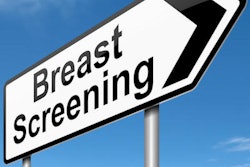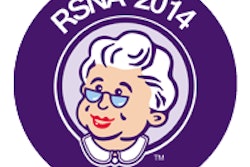
The U.S. could save billions of dollars each year by offering breast cancer screening to women every two years rather than on an annual basis, according to a study in the February 4 issue of Annals of Internal Medicine. But mammography proponents are already stepping up to dispute the study's findings.
"The debate over how often and at what age mammography screening should be implemented continues," lead author Dr. Cristina O'Donoghue from the University of Illinois told AuntMinnie.com. "In this research, we wanted to ask the question of how much different screening protocols cost -- with the idea that then we could better understand how best to use that money for women's benefit."
Proponents of mammography are criticizing the study for focusing too heavily on cost savings, while papering over the contributions that mammography makes in saving lives in women who are on the margins of currently accepted screening guidelines.
Echoes of USPSTF controversy
In 2009, the U.S. Preventive Services Task Force (USPSTF) recommended biennial screening for women between the ages of 50 and 74. The agency withdrew its recommendation that women 40 to 49 be screened, instead advising them to consult with their physicians.
The decision generated a firestorm of controversy that continues to this day. Some U.S. clinicians and professional organizations -- even the U.S. Department of Health and Human Services (HHS) -- disagree and have ignored the guidelines and rejected the data on which they are based. The American Cancer Society (ACS) has maintained that women should begin annual screening at age 40 and continue throughout their lives.
But according to O'Donoghue's team, the 2009 USPSTF protocol is best for maximizing patient benefit, minimizing harm (false positives, unnecessary biopsies, and patient anxiety), and using healthcare resources effectively.
"The USPSTF recommendations are based on a rigorous review of screening trials and work from the Cancer Intervention and Surveillance Modeling Network investigators that demonstrated that there is little net benefit in increasing the frequency of mammography," they wrote.
Which model is best?
O'Donoghue's team sought to measure the aggregate cost of mammography screening in the U.S., comparing current practice to three different protocols. Using data from 2010 as a base, they found that the estimated cost of mammography screening in the U.S. that year was $7.8 billion, with approximately 70% of women screened (Annals of Internal Medicine, February 4, 2014, Vol. 160:3, pp. 145-153).
The group then simulated three other screening strategies from a payor perspective:
- Annual screening for women 40 to 84
- Biennial screening for women 50 to 69
- Screening based on USPSTF's 2009 guidelines, with biennial screening for women 50 to 74 and personalized screening based on risk for those younger than 50 and based on comorbid conditions for those older than 74
The final data included the costs of mammography exams, computer-aided detection, recalls, and biopsies, according to O'Donoghue and colleagues, including senior author Dr. Laura Esserman of the University of California, San Francisco.
 Dr. Cristina O'Donoghue from the University of Illinois.
Dr. Cristina O'Donoghue from the University of Illinois.The group found that the simulated cost of screening 85% of women was $10.1 billion, $2.6 billion, and $3.5 billion for the annual, biennial, and USPSTF protocols, respectively. Although the biennial strategy was the least expensive, the USPSTF protocol includes screening of high-risk women between the ages of 40 and 49 and women between the ages of 75 and 85 with three or fewer comorbid conditions, the authors noted.
"Mammography screening is resource-intensive at an estimated cost of $7.8 billion per year as currently practiced," they wrote. "Following mammography screening guidelines, such as those from the USPSTF, that optimize frequency on the basis of best available evidence, will put us in a position to improve screening and save billions of dollars that can be invested in personalized risk-based screening and prevention strategies."
In an editorial published in the same issue, Dr. Joann Elmore from the University of Washington and Dr. Cary Gross from Yale University lauded the research.
"Women and their providers do not know the costs associated with breast cancer screening, and national organizations have been hesitant to discuss this issue," they wrote. "We applaud O'Donoghue and colleagues for meticulously assessing the total cost of breast cancer screening in the United States."
"Although there is often cause to be skeptical about simulation models because results are based on numerous assumptions, we find the article by O'Donoghue and colleagues to be reasonable and conservative," Elmore and Gross wrote.
Should screening be based on cost?
But is a straight cost analysis the best way to determine how screening mammography should be implemented? No, according to Dr. David Dershaw from Memorial Sloan-Kettering Cancer Center. Dershaw served on a panel about breast cancer screening controversies at the recent RSNA meeting.
It is important to discuss healthcare costs, but not in isolation from other considerations -- such as lives saved by an annual screening mammography protocol, he told AuntMinnie.com.
"This article is based on the assumption that the USPSTF's 2009 report reached appropriate conclusions," he said. "And absent from both the article and the editorial commentary is any discussion about lives saved by annual screening that starts when women are 40."
Also, the study makes suppositions about how much money is appropriate to spend on breast cancer screening, Dershaw said.
"In 2004, colorectal screening cost $8.4 billion -- it would be more now, in 2014 dollars -- and the incidence of colorectal cancer, which affects 10% of the population, is way down," he said. "But there's no controversy there. And in 2010, the cost of treating hypertension in this country was $43 billion, including $20 billion in prescription drugs. Twenty-five percent of people aged 18 or older were treated for hypertension in 2010. That's a lot of money, but there's no discussion about whether hypertension treatment should start at 40 rather than at 18."
It's appropriate to know what healthcare interventions cost and how much benefit women get from screening, Dershaw said. But the current study is based on data that have largely been abandoned by the medical community.
"There are reasonable ways to discuss costs," he said. "But we can't talk about how many dollars we'll save without also talking about how many lives we're going to lose."
The study also drew fire from the American College of Radiology (ACR) and the Society of Breast Imaging (SBI) in a statement.
"[The article] provides an incomplete picture of the costs versus benefit of breast cancer screening programs and is misleading," the organizations said. "The costs of morbidity, lost income, treatment of metastatic disease, death, and other real financial implications associated with a diagnosis of advanced breast cancer due to less frequent screening were not considered in [this] analysis."
The groups cited a recent study in the American Journal of Roentgenology that claimed that if the 2009 USPSTF guidelines were followed, approximately 6,500 to 10,000 additional women in the U.S. would die each year from breast cancer. What's more, using 2009 USPSTF data, the cost per life year saved is well under the $75,000 to $100,000 per quality-adjusted life year (QALY) that is considered a cost-effective intervention.
But the purpose of the current study wasn't to argue that there's too much money being spent on breast cancer screening, but rather to shed light on how existing resources could be better used, O'Donoghue told AuntMinnie.com.
"We want to save more lives -- by doing a better job with screening," she said. "And to do that we need to assess whether healthcare resources that are currently supporting annual mammography could be better used so that women who are at high risk for breast cancer receive the screening they need."



















